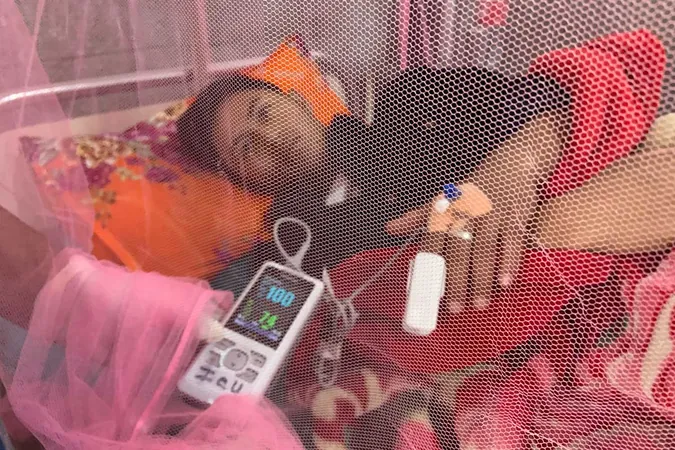
Nepal Faces Dual Crisis: Dengge Outbreak Amidst Climate Change Challenges
2024-11-22
Author: Jia
As Nepal grapples with the realities of climate change, the nation is simultaneously contending with an alarming rise in dengue cases. The situation reached a critical point in 2022, when Dr. Sher Bahadur Pun, an esteemed infectious disease expert at Sukraraj Tropical and Infectious Disease Hospital (STIDH) in Kathmandu, described feelings of helplessness as patient numbers surged dramatically. The hospital, typically managing 70 to 100 patients daily, found itself overwhelmed with nearly 1,000 patients each day at the height of the dengue epidemic.
The strain on healthcare facilities was palpable. With every indoor space filled to capacity, medical staff resorted to providing outpatient services outdoors. Dr. Pun vividly recalls the situation, stressing how the hospital's infrastructure struggled as intensive care units became full and general wards overflowed with patients resting on mats on the floor.
The Unfolding Crisis: A Surge in Cases
Private hospitals were not exempt from the chaos. Dr. Bishad Dahal, an internal medicine resident at Kathmandu Medical College, shared his experience during the outbreak, emphasizing the exhausting hours required to manage both admitted and outpatient dengue cases. This relentless cycle continued until the advent of winter, when case numbers finally began to decline. However, for healthcare workers, the memories of the harrowing 2022 outbreak remain vivid, as seasonal dengue episodes have now become an annual routine since then.
A Deep-rooted Problem: The History of Dengue in Nepal
Dengue made its first appearance in Nepal in 2004, attributed to a Japanese traveler who contracted the virus in India. The first local outbreak was recorded in 2006 in Chitwan, with cases initially confined to the low-lying Terai region bordering India. The situation escalated in subsequent years, with significant outbreaks noted in 2010 and 2013 as the virus spread into other areas of the country, including hilly and mountainous regions.
The frequency of outbreaks increased significantly after 2022, marking a departure from the past pattern of outbreaks occurring every two to three years. The continuous rise in cases has alarmed healthcare officials as they face growing pressure on the healthcare system.
Complex Interplay: Dengue, Climate Change, and Urban Development
Dengue is not merely a health issue; it intertwines with broader environmental concerns. Recent catastrophic floods and landslides in Nepal have bred further complications. The World Health Organization has identified a correlation between climate change and the increase in dengue cases. As rainfall patterns shift, urban areas—with their abundance of waterlogged habitats—serve as fertile ground for mosquito breeding, exacerbating the problem. A poignant example is 17-year-old Ujjwal Timilsina, who contracted dengue shortly after his household was affected by flooding.
As the pattern of outbreaks follows the monsoon season, urban centers like Kathmandu and Pokhara are increasingly facing heightened risks. The connection between the intensity of rainfall, subsequent water pooling, and mosquito proliferation underscores the urgency of addressing climate change.
Preparedness Efforts: Fighting Back Against Dengue
Despite the daunting challenge posed by the dengue virus, Nepal's healthcare system has shown its resilience and capacity for adaptation. Dr. Gokarna Dahal from the Epidemiology and Disease Control Division highlighted steps taken to confront the impending outbreaks. Initiatives like extensive "mosquito search and destruction" programs have been implemented, and healthcare facilities have bolstered their stock of medicines and diagnostic kits in preparation.
Timely training for medical staff prior to the monsoon season signifies a proactive approach aimed at reducing infection rates. This year, as cases surge once more, healthcare professionals remain on high alert and ready to mobilize resources swiftly.
Conclusion: A Dual Challenge
The situation in Nepal is a stark reminder of how intertwined health crises and environmental issues can be. While the struggle against dengue continues, the underlying factors of climate change demand immediate and concerted action. As healthcare providers ramp up their efforts, a collaborative response addressing both health and environmental factors may ultimately pave the way for a healthier future for the nation.



 Brasil (PT)
Brasil (PT)
 Canada (EN)
Canada (EN)
 Chile (ES)
Chile (ES)
 España (ES)
España (ES)
 France (FR)
France (FR)
 Hong Kong (EN)
Hong Kong (EN)
 Italia (IT)
Italia (IT)
 日本 (JA)
日本 (JA)
 Magyarország (HU)
Magyarország (HU)
 Norge (NO)
Norge (NO)
 Polska (PL)
Polska (PL)
 Schweiz (DE)
Schweiz (DE)
 Singapore (EN)
Singapore (EN)
 Sverige (SV)
Sverige (SV)
 Suomi (FI)
Suomi (FI)
 Türkiye (TR)
Türkiye (TR)